Have you ever heard of something called a mommy sippy cup or mommy juice? No? Neither did I, until I signed up for a class all about it. After my first day in class, I have seen so many mommy sippy cups and things related to moms drinking. “The tumbler of mommy juice became the signal of the end of a day of parenting—a hard-earned reward, an escape form the difficulty of the day” (Ravishly). Take a look at this cup!
 Isn’t it SO cute! Okay okay, but actually though, you might be wondering if that product is real. Check out this link to go buy one for yourself (Just kidding. I don’t endorse that): https://www.etsy.com/market/mommy%27s_sippy_cup
Isn’t it SO cute! Okay okay, but actually though, you might be wondering if that product is real. Check out this link to go buy one for yourself (Just kidding. I don’t endorse that): https://www.etsy.com/market/mommy%27s_sippy_cup
Here are a few questions to ask yourself before you continue reading:
- Have you ever seen your mom, or a mom you know, drink?
- Does that mom have children?
- Does that mom have young children?
- Have you ever been stressed about something, and taken a drink because of it?
If the answers to these questions were yes, you should probably keep reading.
As you know, the internet, texts, fliers, and social media are full of something called memes. According to dictionary.com, a meme is “a humorous image, video, piece of text that is copied (often with slight variations) and spread rapidly by Internet users.” Pay attention to the word in red. Humorous. That’s important. Memes are supposed to be funny. Memes are supposed to be spread from people to people. Platform to platform. But where is the line of something being funny and something being dangerous and wrong? Below I discuss a few memes that have come to my attention.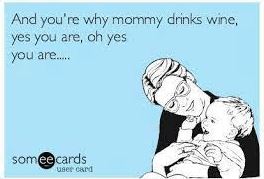 This one is just sad. This meme makes it appear as if mothers only drink because of their children, as if their children cause so much pain and stress in their lives. People who are not mothers view this as funny. They view this as reality. They view this as….well, “if this is true, do I really want to have children?” The next meme (below) shows the same concept. “Make sure you get your mom a bottle of wine for Mother’s Day. After all, you are the reason she drinks.” If I heard someone tell me this, I’d be so offended. Unfortunately, sometimes this is true. People drink to forget. The consequences of memes like this are that some women will believe them, and some mom’s will think it’s okay to drink all the time just to take the edge off of being a mother. Let’s not forget most meme users are younger. Just imagine for a second: all these young girls seeing these memes and wondering if they are true.
This one is just sad. This meme makes it appear as if mothers only drink because of their children, as if their children cause so much pain and stress in their lives. People who are not mothers view this as funny. They view this as reality. They view this as….well, “if this is true, do I really want to have children?” The next meme (below) shows the same concept. “Make sure you get your mom a bottle of wine for Mother’s Day. After all, you are the reason she drinks.” If I heard someone tell me this, I’d be so offended. Unfortunately, sometimes this is true. People drink to forget. The consequences of memes like this are that some women will believe them, and some mom’s will think it’s okay to drink all the time just to take the edge off of being a mother. Let’s not forget most meme users are younger. Just imagine for a second: all these young girls seeing these memes and wondering if they are true.
Please tell me how the below meme is okay. What if it is true? There has to be some truth to this in some cases. Props to stay at home mothers. That is a full time job and some say the hardest job of all. However, if you are a daytime drinking, stay at home mom, looking after a child, isn’t that a contradiction? How can you be looking after a child and also drinking? Not all of your focus will be on that child. Accordin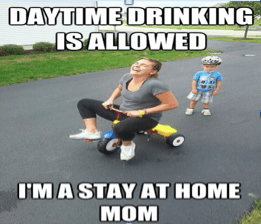 g to Women’s Health Magazine, daytime drinking can lead to:
g to Women’s Health Magazine, daytime drinking can lead to:
- It becoming a habit
- Getting dehydrated
- Drinking way more than you expect to
And, just imagine if your babysitter did that while watching your child.
What my point is…..
These mommy memes are not cool or funny. They shouldn’t exist, and they should not be spreading across the Internet like wildfire. Young girls and boys are on the internet everyday. Their lives revolve around it. They want to share things they think are funny- including these mommy memes. Some consequences of these memes and mommy sippy cup products are that some of these young girls are going to think that it is okay to drink. And, with the increasing amount of women drinking these days, this is even worse. The earlier people are introduced to the concept of drinking, the worse it is.
Lastly, here’s a mother’s point about these memes:
She believes that these mommy memes and quotes are not “message(s) I’m comfortable with my kids seeing as normal or usual. I don’t want my kids to think that I’m counting the minutes until it’s 5pm somewhere” (Ravishly). She believes that alcohol use should not be normalized, and that it harms families and kids who grow up in an environment where it is in use and where they feel unwanted.
Here are the biggest consequences of these memes:
- Mom’s start believing them and thinking it is normal to drink everyday
- Increasing the likelihood of alcohol dependence
- Children thinking they can drink because their mom drinks
- Children thinking their parents do not love them
Websites used:
https://www.dictionary.com/browse/meme
https://www.womenshealthmag.com/health/a19934218/dangers-of-day-drinking/





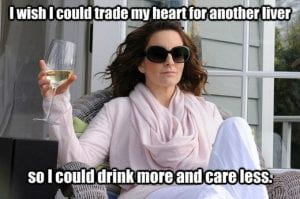



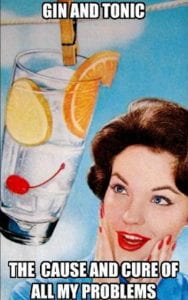





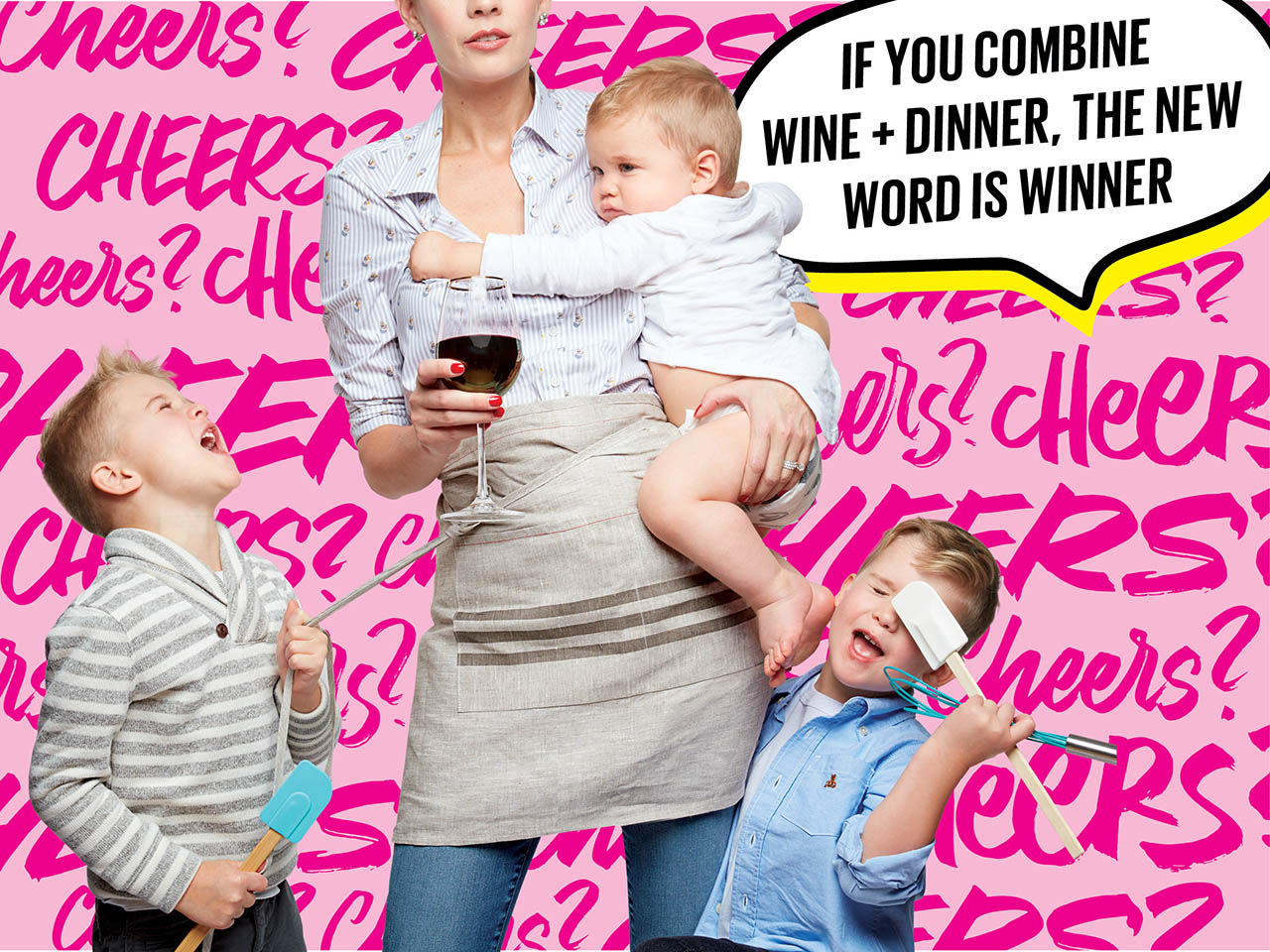






 Similarly, another meme featuring celebrity Aubrey Plaza chugging from a wine bottle says “Just when I think I cant take it anymore… But then I remembered that alcohol existed.” Grammar aside, this makes reference to at best a tough day and at worst depression and other mental health concerns like suicide. Plaza is a comedic actor known for taking roles with dramatic substance and alcohol consumption central to the
Similarly, another meme featuring celebrity Aubrey Plaza chugging from a wine bottle says “Just when I think I cant take it anymore… But then I remembered that alcohol existed.” Grammar aside, this makes reference to at best a tough day and at worst depression and other mental health concerns like suicide. Plaza is a comedic actor known for taking roles with dramatic substance and alcohol consumption central to the  Peer pressure is another form of negative reinforcement that encourages women to drink more. This meme “I saw a husband cheering on his wife to chug her margarita at dinner….that’s the type of relationship I want.” Is scary for many reasons. When there is a mismatch of genders present when alcohol is consumed it often is more dangerous for the women than the men. While this meme clearly describes a married couple, domestic violence and sober consent are still issues at play. If you removed the ‘husband’ and ‘wife’ from this scenario it sounds like a predatory man trying to get a women drunk for potentially nefarious reasons…and the onlooker being envious of this situation. While this is likely not the case here, the meme still normalizes chugging of hard liquor and makes it sound like an ideal significant other is one who encourages you to do so.
Peer pressure is another form of negative reinforcement that encourages women to drink more. This meme “I saw a husband cheering on his wife to chug her margarita at dinner….that’s the type of relationship I want.” Is scary for many reasons. When there is a mismatch of genders present when alcohol is consumed it often is more dangerous for the women than the men. While this meme clearly describes a married couple, domestic violence and sober consent are still issues at play. If you removed the ‘husband’ and ‘wife’ from this scenario it sounds like a predatory man trying to get a women drunk for potentially nefarious reasons…and the onlooker being envious of this situation. While this is likely not the case here, the meme still normalizes chugging of hard liquor and makes it sound like an ideal significant other is one who encourages you to do so. Recently, posts by twitter users have been screenshot and turned into memes. “One time when I was drunk a guy asked me if I’d go on a date with him and I said ‘ok! But when I’m sober I’m not going to want to anymore’ and I think about that a lot.” This one delves deeper into the potentially dangerous situations women can end up in when making inebriated decisions. Dangerous or not, they are often decisions women just don’t want to be in. This author at least is self reflecting and acknowledging the difference between her sober and drunk decision making, but this example is unique in that her reflection came while drunk – not the next day when hungover wondering why the night before turned out as it did.
Recently, posts by twitter users have been screenshot and turned into memes. “One time when I was drunk a guy asked me if I’d go on a date with him and I said ‘ok! But when I’m sober I’m not going to want to anymore’ and I think about that a lot.” This one delves deeper into the potentially dangerous situations women can end up in when making inebriated decisions. Dangerous or not, they are often decisions women just don’t want to be in. This author at least is self reflecting and acknowledging the difference between her sober and drunk decision making, but this example is unique in that her reflection came while drunk – not the next day when hungover wondering why the night before turned out as it did.





